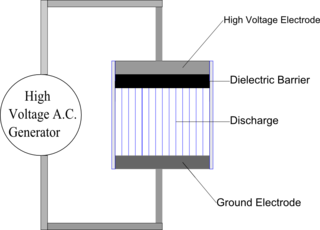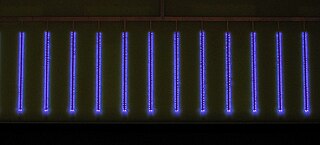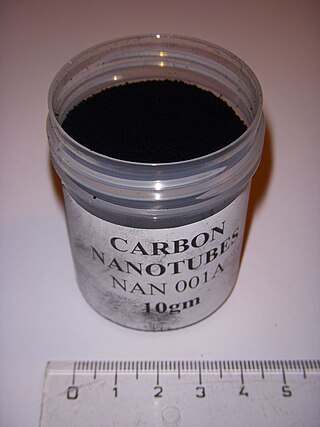Related Research Articles

Chemical vapor deposition (CVD) is a vacuum deposition method used to produce high-quality, and high-performance, solid materials. The process is often used in the semiconductor industry to produce thin films.

The Haber process, also called the Haber–Bosch process, is the main industrial procedure for the production of ammonia. The German chemists Fritz Haber and Carl Bosch developed it in the first decade of the 20th century. The process converts atmospheric nitrogen (N2) to ammonia (NH3) by a reaction with hydrogen (H2) using an iron metal catalyst under high temperatures and pressures. This reaction is slightly exothermic (i.e. it releases energy), meaning that the reaction is favoured at lower temperatures and higher pressures. It decreases entropy, complicating the process. Hydrogen is produced via steam reforming, followed by an iterative closed cycle to react hydrogen with nitrogen to produce ammonia.
A plasma afterglow is the radiation emitted from a plasma after the source of ionization is removed. The external electromagnetic fields that sustained the plasma glow are absent or insufficient to maintain the discharge in the afterglow. A plasma afterglow can either be a temporal, due to an interrupted (pulsed) plasma source, or spatial, due to a distant plasma source. In the afterglow, plasma-generated species de-excite and participate in secondary chemical reactions that tend to form stable species. Depending on the gas composition, super-elastic collisions may continue to sustain the plasma in the afterglow for a while by releasing the energy stored in rovibronic degrees of freedom of the atoms and molecules of the plasma. Especially in molecular gases, the plasma chemistry in the afterglow is significantly different from the plasma glow. The afterglow of a plasma is still a plasma and as thus retains most of the properties of a plasma.

Thermogravimetric analysis or thermal gravimetric analysis (TGA) is a method of thermal analysis in which the mass of a sample is measured over time as the temperature changes. This measurement provides information about physical phenomena, such as phase transitions, absorption, adsorption and desorption; as well as chemical phenomena including chemisorptions, thermal decomposition, and solid-gas reactions.
The water–gas shift reaction (WGSR) describes the reaction of carbon monoxide and water vapor to form carbon dioxide and hydrogen:
An atmospheric pressure discharge is an electrical discharge in air or another gas at atmospheric pressure.
Plasma activation is a method of surface modification employing plasma processing, which improves surface adhesion properties of many materials including metals, glass, ceramics, a broad range of polymers and textiles and even natural materials such as wood and seeds. Plasma functionalization also refers to the introduction of functional groups on the surface of exposed materials. It is widely used in industrial processes to prepare surfaces for bonding, gluing, coating and painting. Plasma processing achieves this effect through a combination of reduction of metal oxides, ultra-fine surface cleaning from organic contaminants, modification of the surface topography and deposition of functional chemical groups. Importantly, the plasma activation can be performed at atmospheric pressure using air or typical industrial gases including hydrogen, nitrogen and oxygen. Thus, the surface functionalization is achieved without expensive vacuum equipment or wet chemistry, which positively affects its costs, safety and environmental impact. Fast processing speeds further facilitate numerous industrial applications.

Dielectric-barrier discharge (DBD) is the electrical discharge between two electrodes separated by an insulating dielectric barrier. Originally called silent (inaudible) discharge and also known as ozone production discharge or partial discharge, it was first reported by Ernst Werner von Siemens in 1857.
A microplasma is a plasma of small dimensions, ranging from tens to thousands of micrometers. Microplasmas can be generated at a variety of temperatures and pressures, existing as either thermal or non-thermal plasmas. Non-thermal microplasmas that can maintain their state at standard temperatures and pressures are readily available and accessible to scientists as they can be easily sustained and manipulated under standard conditions. Therefore, they can be employed for commercial, industrial, and medical applications, giving rise to the evolving field of microplasmas.

The Wingless Electromagnetic Air Vehicle (WEAV) is a heavier than air flight system developed at the University of Florida, funded by the Air Force Office of Scientific Research. The WEAV was invented in 2006 by Dr. Subrata Roy, plasma physicist, aerospace engineering professor at the University of Florida, and has been a subject of several patents. The WEAV employs no moving parts, and combines the aircraft structure, propulsion, energy production and storage, and control subsystems into one integrated system.
An ionization instability is any one of a category of plasma instabilities which is mediated by electron-impact ionization. In the most general sense, an ionization instability occurs from a feedback effect, when electrons produced by ionization go on to produce still more electrons through ionization in a self-reinforcing way.

Plasma is one of four fundamental states of matter, characterized by the presence of a significant portion of charged particles in any combination of ions or electrons. It is the most abundant form of ordinary matter in the universe, mostly in stars, but also dominating the rarefied intracluster medium and intergalactic medium. Plasma can be artificially generated, for example, by heating a neutral gas or subjecting it to a strong electromagnetic field.

Plasma actuators are a type of actuator currently being developed for aerodynamic flow control. Plasma actuators impart force in a similar way to ionocraft. Plasma flows control has drawn considerable attention and been used in boundary layer acceleration, airfoil separation control, forebody separation control, turbine blade separation control, axial compressor stability extension, heat transfer and high-speed jet control.
Plasma medicine is an emerging field that combines plasma physics, life sciences and clinical medicine. It is being studied in disinfection, healing, and cancer. Most of the research is in vitro and in animal models.

In electromagnetism, a streamer discharge, also known as filamentary discharge, is a type of transient electric discharge which forms at the surface of a conductive electrode carrying a high voltage in an insulating medium such as air. Streamers are luminous writhing branching sparks, plasma channels composed of ionized air molecules, which repeatedly strike out from the electrode into the air.
Piezoelectric direct discharge (PDD) plasma is a type of cold non-equilibrium plasma, generated by a direct gas discharge of a high voltage piezoelectric transformer. It can be ignited in air or other gases in a wide range of pressures, including atmospheric. Due to the compactness and the efficiency of the piezoelectric transformer, this method of plasma generation is particularly compact, efficient and cheap. It enables a wide spectrum of industrial, medical and consumer applications.

Techniques have been developed to produce carbon nanotubes in sizable quantities, including arc discharge, laser ablation, high-pressure carbon monoxide disproportionation, and chemical vapor deposition (CVD). Most of these processes take place in a vacuum or with process gases. CVD growth of CNTs can occur in vacuum or at atmospheric pressure. Large quantities of nanotubes can be synthesized by these methods; advances in catalysis and continuous growth are making CNTs more commercially viable.
Vertically aligned carbon nanotube arrays (VANTAs) are a unique microstructure consisting of carbon nanotubes oriented with their longitudinal axis perpendicular to a substrate surface. These VANTAs effectively preserve and often accentuate the unique anisotropic properties of individual carbon nanotubes and possess a morphology that may be precisely controlled. VANTAs are consequently widely useful in a range of current and potential device applications.
Praseodymium(III,IV) oxide is the inorganic compound with the formula Pr6O11 that is insoluble in water. It has a cubic fluorite structure. It is the most stable form of praseodymium oxide at ambient temperature and pressure.
Heinz Artur Raether was a German physicist. He is best known for his theoretical and experimental contributions to the study of surface plasmons, as well as for Kretschmann-Raether configuration, a commonly-used experimental setup for the excitation of surface plasmon resonances.
References
- ↑ von Engel, A. and Cozens, J.R. (1976) "Flame Plasma" in Advances in electronics and electron physics, L. L. Marton (ed.), Academic Press, ISBN 978-0-12-014520-1, p. 99 Archived 2 December 2016 at the Wayback Machine
- ↑ "Decontamination of Fresh Production with Cold Plasma". U.S. Department of Agriculture. Retrieved 2006-07-28.
- ↑ Laroussi, M. (1996). “Sterilization of Contaminated Matter by an Atmospheric Pressure Plasma”, IEEE Trans. Plasma Sci. 34, 1188 – 1191.
- ↑ Ahmadi, Mohsen; Nasri, Zahra; von Woedtke, Thomas; Wende, Kristian (2022). "d-Glucose Oxidation by Cold Atmospheric Plasma-Induced Reactive Species". ACS Omega. 7 (36): 31983–31998. doi:10.1021/acsomega.2c02965. PMC 9475618 . PMID 36119990.
- ↑ Nasri, Zahra; Memari, Seyedali; Wenske, Sebastian; Clemen, Ramona; Martens, Ulrike; Delcea, Mihaela; Bekeschus, Sander; Weltmann, Klaus‐Dieter; Woedtke, Thomas; Wende, Kristian (2021). "Singlet-Oxygen-Induced Phospholipase A2 Inhibition: A Major Role for Interfacial Tryptophan Dioxidation". Chemistry – A European Journal. 27 (59): 14702–14710. doi:10.1002/chem.202102306. PMC 8596696 . PMID 34375468.
- ↑ Wende, K.; Nasri, Z.; Striesow, J.; Ravandeh, M.; Weltmann, K.-D.; Bekeschus, S.; Woedtke, T. von (2022). "Is Biomolecule Oxidation by Plasma-Derived Reactive Species Restricted to the Gas-Liquid Interphase?". 2022 IEEE International Conference on Plasma Science (ICOPS). pp. 1–2. doi:10.1109/ICOPS45751.2022.9813129. ISBN 978-1-6654-7925-7. S2CID 250318321 . Retrieved 2022-07-01.
- ↑ Ahmadi, Mohsen; Potlitz, Felix; Link, Andreas; von Woedtke, Thomas; Nasri, Zahra; Wende, Kristian (2022). "Flucytosine-based prodrug activation by cold physical plasma". Archiv der Pharmazie. 355 (9): e2200061. doi: 10.1002/ardp.202200061 . PMID 35621706. S2CID 249095233.
- ↑ "Plasma rips away tenacious tooth bacteria". 2009-06-11. Retrieved 2009-06-20.
- ↑ Beth Dunham (June 5, 2009). "Cool plasma packs heat against biofilm". Archived from the original on June 18, 2009. Retrieved 2009-06-20.
- ↑ Eisenberg, Anne (2010-02-13). "Hospital-Clean Hands, Without All the Scrubbing". The New York Times. Retrieved 2011-02-28.
- ↑ "American Dryer UK Set To Transform Hand Hygiene With Pioneering 'Germ Destroying'". Bloomberg. 2015-03-27. Archived from the original on 2015-04-03.
- ↑ Kuznetsov, I.A.; Saveliev, A.V.; Rasipuram, S.; Kuznetsov, A.V.; Brown, A.; Jasper, W. (2012). Development of Active Porous Medium Filters Based on Plasma Textiles. Porous Media and Its Applications in Science, Engineering and Industry, AIP Conf. Proc. 1453. AIP Conference Proceedings. Vol. 1453. pp. 265–270. Bibcode:2012AIPC.1453..265K. doi:10.1063/1.4711186.
- ↑ Gadri, Rami Ben; Roth, J.Reece; Montie, Thomas C.; Kelly-Wintenberg, Kimberly; Tsai, Peter P.-Y.; Helfritch, Dennis J.; Feldman, Paul; Sherman, Daniel M.; Karakaya, Fuat; Chen, Zhiyu (2000). "Sterilization and plasma processing of room temperature surfaces with a one atmosphere uniform glow discharge plasma (OAUGDP)". Surface and Coatings Technology. Elsevier BV. 131 (1–3): 528–541. doi:10.1016/s0257-8972(00)00803-3. ISSN 0257-8972.
- ↑ Laroussi, M.; Lu, X. (2005-09-12). "Room-temperature atmospheric pressure plasma plume for biomedical applications". Applied Physics Letters. AIP Publishing. 87 (11): 113902. Bibcode:2005ApPhL..87k3902L. doi:10.1063/1.2045549. ISSN 0003-6951.
- ↑ Montie, T.C.; Kelly-Wintenberg, K.; Roth, J.R. (2000). "An overview of research using the one atmosphere uniform glow discharge plasma (OAUGDP) for sterilization of surfaces and materials". IEEE Transactions on Plasma Science. Institute of Electrical and Electronics Engineers (IEEE). 28 (1): 41–50. Bibcode:2000ITPS...28...41M. doi:10.1109/27.842860. ISSN 0093-3813.
- ↑ Lee, Kwon-Yong; Joo Park, Bong; Hee Lee, Dong; Lee, In-Seop; O. Hyun, Soon; Chung, Kie-Hyung; Park, Jong-Chul (2005). "Sterilization of Escherichia coli and MRSA using microwave-induced argon plasma at atmospheric pressure". Surface and Coatings Technology. Elsevier BV. 193 (1–3): 35–38. doi:10.1016/j.surfcoat.2004.07.034. ISSN 0257-8972.
- 1 2 Niemira et al., 2005. P2. IFT NPD Mtg., Wyndmoor, Pennsylvania
- 1 2 NIemira et al., 2005. P2-40. IAFP Mtg., Baltimore, Maryland
- ↑ Sladek, R E J; Stoffels, E (2005-05-20). "Deactivation ofEscherichia coliby the plasma needle". Journal of Physics D: Applied Physics. IOP Publishing. 38 (11): 1716–1721. Bibcode:2005JPhD...38.1716S. doi:10.1088/0022-3727/38/11/012. ISSN 0022-3727. S2CID 95924351.
- ↑ Stoffels, E; Flikweert, A J; Stoffels, W W; Kroesen, G M W (2002-08-30). "Plasma needle: a non-destructive atmospheric plasma source for fine surface treatment of (bio)materials". Plasma Sources Science and Technology. IOP Publishing. 11 (4): 383–388. Bibcode:2002PSST...11..383S. doi:10.1088/0963-0252/11/4/304. ISSN 0963-0252. S2CID 250895777.
- ↑ Deng et al., 2005. Paper #056149, ASAE Ann. Mtg., Tampa, Florida
- ↑ Kelly-Wintenberg, K.; Hodge, Amanda; Montie, T. C.; Deleanu, Liliana; Sherman, Daniel; Reece Roth, J.; Tsai, Peter; Wadsworth, Larry (1999). "Use of a one atmosphere uniform glow discharge plasma to kill a broad spectrum of microorganisms". Journal of Vacuum Science & Technology A: Vacuum, Surfaces, and Films. American Vacuum Society. 17 (4): 1539–1544. Bibcode:1999JVSTA..17.1539K. doi:10.1116/1.581849. ISSN 0734-2101.
- ↑ Laroussi, M; Mendis, D A; Rosenberg, M (2003-04-30). "Plasma interaction with microbes". New Journal of Physics. IOP Publishing. 5 (1): 41. Bibcode:2003NJPh....5...41L. doi: 10.1088/1367-2630/5/1/341 . ISSN 1367-2630.
- ↑ Montenegro, J.; Ruan, R.; Ma, H.; Chen, P. (2002). "Inactivation of E. coli O157:H7 Using a Pulsed Nonthermal Plasma System". Journal of Food Science. Wiley. 67 (2): 646–648. doi:10.1111/j.1365-2621.2002.tb10653.x. ISSN 0022-1147.
- ↑ Abu Rached, Nessr; Kley, Susanne; Storck, Martin; Meyer, Thomas; Stücker, Markus (January 2023). "Cold Plasma Therapy in Chronic Wounds—A Multicenter, Randomized Controlled Clinical Trial (Plasma on Chronic Wounds for Epidermal Regeneration Study): Preliminary Results". Journal of Clinical Medicine. 12 (15): 5121. doi: 10.3390/jcm12155121 . ISSN 2077-0383. PMC 10419810 . PMID 37568525.
- ↑ Kerrebrock, Jack L.; Hoffman, Myron A. (June 1964). "Non-Equilibrium Ionization Due to Electron Heating. Theory and Experiments" (PDF). AIAA Journal. 2 (6): 1072–1087. Bibcode:1964AIAAJ...2.1080H. doi:10.2514/3.2497. Archived from the original (PDF) on 2019-08-19. Retrieved 2018-04-10.
- ↑ Sherman, A. (September 1966). "MHD Channel Flow with Non-Equilibrium lonization" (PDF). The Physics of Fluids. 9 (9): 1782–1787. Bibcode:1966PhFl....9.1782S. doi:10.1063/1.1761933. Archived from the original (PDF) on 2018-04-12. Retrieved 2018-04-10.
- ↑ Argyropoulos, G. S.; Demetriades, S. T.; Kentig, A. P. (1967). "Current Distribution in Non-Equilibrium J×B Devices" (PDF). Journal of Applied Physics. 38 (13): 5233–5239. Bibcode:1967JAP....38.5233A. doi:10.1063/1.1709306.
- ↑ Zauderer, B.; Tate, E. (September 1968). "Electrical characteristics of a linear, nonequilibrium, MHD generator" (PDF). AIAA Journal. 6 (9): 1683–1694. Bibcode:1968AIAAJ...6.1685T. doi:10.2514/3.4846.
- ↑ Haines, M. G.; LePell, P. D.; Coverdale, C. A.; Jones, B.; Deeney, C.; Apruzese, J. P. (23 February 2006). "Ion Viscous Heating in a Magnetohydrodynamically Unstable Pinch at Over 2 × 109 Kelvin" (PDF). Physical Review Letters. 96 (7): 075003. Bibcode:2006PhRvL..96g5003H. doi:10.1103/PhysRevLett.96.075003. PMID 16606100.
- ↑ Petit, J.-P. "The Z Machine: Over two billion degrees! Malcolm Haines' paper" (PDF). Retrieved 2018-04-07.
- ↑ Weier, Tom; Shatrov, Victor; Gerbeth, Gunter (2007). "Flow Control and Propulsion in Poor Conductors". In Molokov, Sergei S.; Moreau, R.; Moffatt, H. Keith (eds.). Magnetohydrodynamics: Historical Evolution and Trends. Springer Science+Business Media. pp. 295–312. doi:10.1007/978-1-4020-4833-3. ISBN 978-1-4020-4832-6.
- 1 2 Whitehead, J Christopher (22 June 2016). "Plasma–catalysis: the known knowns, the known unknowns and the unknown unknowns". Journal of Physics D: Applied Physics. 49 (24): 243001. Bibcode:2016JPhD...49x3001W. doi:10.1088/0022-3727/49/24/243001. S2CID 101887286.
- ↑ Eliasson, B; Hirth, M; Kogelschatz, U (14 November 1987). "Ozone synthesis from oxygen in dielectric barrier discharges". Journal of Physics D: Applied Physics. 20 (11): 1421–1437. Bibcode:1987JPhD...20.1421E. doi:10.1088/0022-3727/20/11/010. S2CID 250811914.
- ↑ Chang, Jen-Shih (December 2001). "Recent development of plasma pollution control technology: a critical review". Science and Technology of Advanced Materials. 2 (3–4): 571–576. Bibcode:2001STAdM...2..571C. doi: 10.1016/S1468-6996(01)00139-5 .
- ↑ Ashford, Bryony; Tu, Xin (February 2017). "Non-thermal plasma technology for the conversion of CO 2". Current Opinion in Green and Sustainable Chemistry. 3: 45–49. doi:10.1016/j.cogsc.2016.12.001.
- ↑ De Bie, Christophe; Verheyde, Bert; Martens, Tom; van Dijk, Jan; Paulussen, Sabine; Bogaerts, Annemie (23 November 2011). "Fluid Modeling of the Conversion of Methane into Higher Hydrocarbons in an Atmospheric Pressure Dielectric Barrier Discharge". Plasma Processes and Polymers. 8 (11): 1033–1058. doi:10.1002/ppap.201100027.
- 1 2 CHEN, H; LEE, H; CHEN, S; CHAO, Y; CHANG, M (17 December 2008). "Review of plasma catalysis on hydrocarbon reforming for hydrogen production—Interaction, integration, and prospects". Applied Catalysis B: Environmental. 85 (1–2): 1–9. doi:10.1016/j.apcatb.2008.06.021.
- ↑ Holzer, F (September 2002). "Combination of non-thermal plasma and heterogeneous catalysis for oxidation of volatile organic compounds Part 1. Accessibility of the intra-particle volume". Applied Catalysis B: Environmental. 38 (3): 163–181. doi:10.1016/S0926-3373(02)00040-1.
- ↑ Neyts, E C; Bogaerts, A (4 June 2014). "Understanding plasma catalysis through modelling and simulation—a review". Journal of Physics D: Applied Physics. 47 (22): 224010. Bibcode:2014JPhD...47v4010N. doi:10.1088/0022-3727/47/22/224010. S2CID 120159417.
- ↑ Harling, Alice M.; Glover, David J.; Whitehead, J. Christopher; Zhang, Kui (July 2009). "The role of ozone in the plasma-catalytic destruction of environmental pollutants". Applied Catalysis B: Environmental. 90 (1–2): 157–161. doi:10.1016/j.apcatb.2009.03.005.
- ↑ Neyts, E C; Bogaerts, A (4 June 2014). "Understanding plasma catalysis through modelling and simulation—a review". Journal of Physics D: Applied Physics. 47 (22): 224010. Bibcode:2014JPhD...47v4010N. doi:10.1088/0022-3727/47/22/224010. S2CID 120159417.
- ↑ Chen, Hsin Liang; Lee, How Ming; Chen, Shiaw Huei; Chang, Moo Been; Yu, Sheng Jen; Li, Shou Nan (April 2009). "Removal of Volatile Organic Compounds by Single-Stage and Two-Stage Plasma Catalysis Systems: A Review of the Performance Enhancement Mechanisms, Current Status, and Suitable Applications". Environmental Science & Technology. 43 (7): 2216–2227. Bibcode:2009EnST...43.2216C. doi:10.1021/es802679b. PMID 19452866.
- ↑ Van Durme, Jim; Dewulf, Jo; Leys, Christophe; Van Langenhove, Herman (February 2008). "Combining non-thermal plasma with heterogeneous catalysis in waste gas treatment: A review". Applied Catalysis B: Environmental. 78 (3–4): 324–333. doi:10.1016/j.apcatb.2007.09.035. hdl: 1854/LU-419124 .
- ↑ Vandenbroucke, Arne M.; Morent, Rino; De Geyter, Nathalie; Leys, Christophe (November 2011). "Non-thermal plasmas for non-catalytic and catalytic VOC abatement". Journal of Hazardous Materials. 195: 30–54. doi:10.1016/j.jhazmat.2011.08.060. PMID 21924828.
- ↑ Blin-Simiand, Nicole; Tardiveau, Pierre; Risacher, Aurore; Jorand, François; Pasquiers, Stéphane (31 March 2005). "Removal of 2-Heptanone by Dielectric Barrier Discharges – The Effect of a Catalyst Support". Plasma Processes and Polymers. 2 (3): 256–262. doi:10.1002/ppap.200400088.
- ↑ Hong, Jingping; Chu, Wei; Chernavskii, Petr A.; Khodakov, Andrei Y. (7 July 2010). "Cobalt species and cobalt-support interaction in glow discharge plasma-assisted Fischer–Tropsch catalysts". Journal of Catalysis. 273 (1): 9–17. doi:10.1016/j.jcat.2010.04.015.
- ↑ Beuther, H.; Larson, O.A.; Perrotta, A.J. (1980). The Mechanism of Coke Formation on Catalysts. Studies in Surface Science and Catalysis. Vol. 6. pp. 271–282. doi:10.1016/s0167-2991(08)65236-2. ISBN 9780444419200.
{{cite book}}:|journal=ignored (help) - ↑ Zhang, Yu-Ru; Van Laer, Koen; Neyts, Erik C.; Bogaerts, Annemie (May 2016). "Can plasma be formed in catalyst pores? A modeling investigation". Applied Catalysis B: Environmental. 185: 56–67. doi:10.1016/j.apcatb.2015.12.009. hdl: 10067/1298080151162165141 .
- ↑ Bednar, Nikola; Matović, Jovan; Stojanović, Goran (December 2013). "Properties of surface dielectric barrier discharge plasma generator for fabrication of nanomaterials". Journal of Electrostatics. 71 (6): 1068–1075. doi:10.1016/j.elstat.2013.10.010.
- ↑ Ramakers, M; Trenchev, G; Heijkers, S; Wang, W; Bogaerts, A (2017). "Gliding Arc Plasmatron: Providing an Alternative Method for Carbon Dioxide Conversion". ChemSusChem. 10 (12): 2642–2652. Bibcode:2017ChSCh..10.2642R. doi:10.1002/cssc.201700589. hdl: 10067/1441840151162165141 . PMID 28481058.